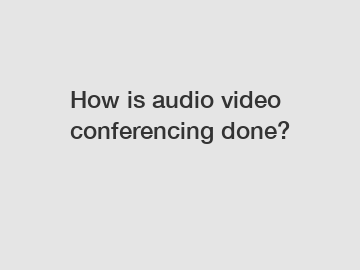How is audio video conferencing done?
Audio Video Conferencing: A Comprehensive Guide.
Audio video conferencing has revolutionized the way people communicate and collaborate in today's digital age. It allows individuals or groups separated by geographical distances to interact in real-time through audio and video communication. This article will delve into the process of how audio video conferencing is done, exploring the technology behind it and the steps involved in setting up a conference call.
Technology behind Audio Video Conferencing.

Audio video conferencing relies on a combination of hardware and software to facilitate seamless communication. The primary components include cameras, microphones, speakers, codecs, and network connections. Cameras capture video feeds, while microphones capture audio inputs. The codecs compress and decompress audio and video data, ensuring smooth transmission over the network. Network connections, whether through the internet or dedicated lines, play a crucial role in maintaining connectivity during conferencing sessions.
Setting up an Audio Video Conference.
1. Choosing the Right Platform: There are numerous audio video conferencing platforms available, each offering various features and functionalities. Factors to consider when selecting a platform include the number of participants, desired features (such as screen sharing or recording), and compatibility with different devices.
2. Scheduling the Conference: Once the platform is chosen, the next step is to schedule the conference call. Participants should receive invitations with the date, time, and a link to join the conference. It is essential to consider time zone differences when scheduling international meetings.
3. Testing Equipment: Before the scheduled conference, it is crucial to test all audio and video equipment to ensure they are working correctly. This includes checking cameras, microphones, speakers, and internet connectivity. Testing helps prevent technical issues during the actual conference call.
4. Joining the Conference: On the day of the conference, participants can join by clicking the provided link or dialing in using a phone number. It is recommended to join a few minutes early to address any last-minute technical issues.
5. Conducting the Conference: During the conference call, participants can communicate through audio and video feeds. Features like screen sharing, chat, and recording may be available depending on the platform used. It is essential to follow proper etiquette, such as muting the microphone when not speaking and maintaining a professional demeanor.
Conclusion.
Audio video conferencing has become an indispensable tool for businesses, educational institutions, and individuals looking to connect with others remotely. The technology behind audio video conferencing, coupled with the steps involved in setting up a conference call, ensures seamless communication across distances. By understanding the process of how audio video conferencing is done, individuals can leverage this powerful tool to enhance collaboration and productivity.
Contact Us.
For more information on audio video conferencing solutions or to schedule a demo, please contact us today. Embrace the future of communication with our advanced conferencing technologies.
Are you interested in learning more about wireless conference room microphone system, 4k video wall controller, Digital Discussion System? Contact us today to secure an expert consultation!
26
0
0

Comments
All Comments (0)